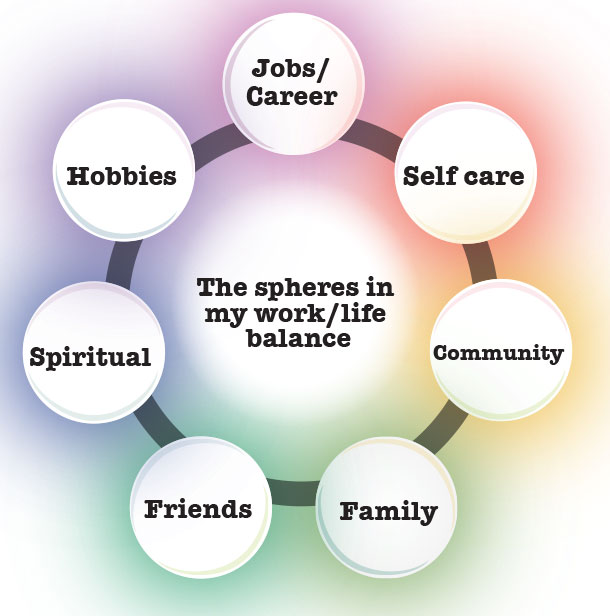“By working faithfully eight hours a day, you may eventually get to be boss and work 12 hours a day.”—Robert Frost We may have our daily schedule written down or have a good idea of what it looks like in our mind. Before we know it, we are double-booked and are trying to squeeze in one more thing. Then one kid sends a text:
The 4-H meeting is tonight, and he signed up to bring cookies – and forgot to mention it until now. You get home, and there are at least two loads of laundry to do. Once you realize today’s date, you remember that the kids’ cattle show entries are due tomorrow.
There are four “return phone call” notes on your desk. Life happens, and soon it feels like you don’t even have time to go to the bathroom. I know some of you reading this are nodding.
Work-life balance is the concept of including proper prioritizing between “work” and “lifestyle.” The so-called “balance” is about the choices we make. The graphic is a schematic that demonstrates what I consider the important spheres.

We would expect job/career and family and hobbies to perhaps be included, but what about self-care or community or spirituality? In my life, these spheres are sometimes forgotten.
Work-life balance is not limited to our fast-paced society. The dichotomy of work-leisure was invented in the mid-1800s. Author and journalist Paul Krassner remarked that anthropologists use a definition of happiness as little separation between work and play.
In more modern times, Tom Brown first published the term “work-life” in an Industry Week article in 1986.
He wrote, “It used to be that work-and-life balance was a boutique issue; you know, something that would be great to worry about whenever – and if – one had some free time.
But imbalance is killing people.” Two years later, he revised the term, removed the “and” and wrote “A model employee is [one] who demonstrates a healthy work-life balance. In every company I know, the workaholic is alive – and sick.”
Balance is not gender-specific. According to the Center for American Progress, over 90 percent of working mothers and fathers report work-family conflict. Men and women handle balance differently.
While changing, our society has social norms that pit “the ideal worker” against those who have caretaker roles. In fact, women have a more positive viewpoint than men toward their employer’s efforts to help them balance work and life, perhaps because of awareness specifically as it applies to women.
A 2015 Ernst & Young generation survey reported that one-third of full-time workers say managing a day job and having a life has become tougher in the last five years. Both the domestic and market labor compete for time and energy for women.
Some 64 percent of mothers with the youngest child under 6 and 77 percent with the youngest child 6 to 17 are employed. This indicates the majority of women with dependant care responsibilities cannot or do not wish to give up careers.
Men feel this “tug of war” also. They do not see work alone as providing their lives with full satisfaction. Like women, they are looking for more flexibility. A study on fatherhood back in 2010 found that men were looking for alternatives to their 40-hour work week to spend more time with family.
However, working less can mean a smaller paycheck and a resulting higher stress level. Overall, traditionalism is becoming less frequent due to what is practical for each individual family.
Family dynamics come into play with balance. Obviously, as the number of children increase, there is more activity to balance. While very young children are high-demand, teenagers begin to have social lives and activities that keep adults busy. It is also not uncommon for grandparents to play a major role in raising grandchildren in today’s environment.
This adds stress to working grandparents. Family members also may face responsibilities of caring for their aging parents or other family members.
Marital status plays a role in work-family-related stress. As family life is complicated by divorce, shared custody, single-parent households, child support and alimony payments, stress may increase due to financial and emotional strain.
Religion and sexual orientation are often given little thought. If workers feel marginalized, excluded, unaccepted or disrespected, their work stress increases.
Personality is an influencer to balancing work-life. The International Journal of Management and Marketing Research published a study in 2014 focusing on the personality traits of banking professionals in India. They concluded that extraverted bankers were able to balance work and life more effectively and with less stress than the other groups.
They exhibited gregariousness, warmth and assertiveness. The agreeable group, which was next in line, was somewhat less effective. They were compliant, modest and straightforward. The conscientiousness group followed the agreeable group. They were compliant, dutiful and orderly.
The open-minded and the neuroticism groups were the lowest. The open-minded group was caught up in feelings, ideas and aesthetics, and the neuroticism group was unable to balance work-life because they were anxious, vulnerable, hostile and depressed.
The take-home message in this study was for people to honestly evaluate their personality and find a career that best suits their strengths. Individuals must understand their goals, self-management and time management, how to improve on their weaknesses and strive for balance through personality development.
Work-life balance information ranges from either being pro-work or pro-life. However, all approaches agree that a logical first step is to understand your immediate and longer-term goals.
Ask yourself: Where am I headed? What is important? How do I feel about it? How do my family, employer and support network feel about it?
Life is dynamic, and it is not reasonable for our life spheres to be equal. Look at Figure 1 again. Our first step was to recognize that all of the different spheres exist. Not every sphere should or can be the same size.
It is natural to have some spheres larger than others. Sphere size will vary person to person and will fluctuate over time. The challenge is to allow all spheres to exist and to understand which spheres should be the largest and the smallest at any given time.
Put another way, the Fast Company published a list of seven habits of people who have achieved work-life balance.
- Make deliberate choices about what you want in life and how you want to spend your time.
- Communicate about what is working and what is not.
- Time is set aside for family, friends and important interests.
- Set your own parameters around success.
- Turn off distractions. Multitasking is a myth. Focus on the task at hand.
- Have goals aligned with pursuing your passion.
- Developed a strong support network.
Based on my own life, I have also developed a short list of lessons and patterns I’ve learned to help me manage my own work-life balance. My first lesson was that I could not please everyone. Coming straight out of veterinary school and jumping into the dairy industry was not exactly easy or encouraging at times.
I know I am not the lone people-pleaser, and it is common for women to focus on others. I realized that I was miserable trying to make everyone happy.
This led to my second lesson: Relationships need to be mutually beneficial. Once I realized I was miserable, I eliminated relationships that were of no benefit to me. This may sound strange for someone in a service industry. However, I chose to be in the service industry so I could help people, primarily by helping their animals.
So I focused in areas where I knew I was making a difference, with people I enjoyed working with, and areas that I became confident and proficient in.
The next lesson is that relationships ebb and flow. The dairy industry is growing smaller each year. It is really important not to burn a bridge that you may later need to cross.
Business is business, and I learned quickly to not take challenges personally. In turn, when I needed to give criticism, it was important to focus on the action and not the person. As an employer and a service provider, I have gotten better at hiring and relationship building.
Another key point is to make sure your values are aligned with those around you. It is much easier to work with someone if you are both working toward common goals and have common values.
If you aren’t sure, ask a potential employer or team member or vendor what is important to them and what their goals are. These are the folks that may be part of your support team, so choose wisely.
Next, realize that you can’t do it all, so accept help. In a twisted way, you are really helping other people when you allow them to help you, so it is a win-win.
My very last viewpoint is that things never go as planned. But thankfully, there is opportunity in every challenge. Once you embrace that truth, you can enjoy the ride. ![]()
Angela M. Daniels is a veterinarian at Circle H Animal Health LLC in Dalhart, Texas, which she co-owns with her husband, C. Scanlon Daniels, DVM.
ILLUSTRATION: Illustration by Corey Lewis.






